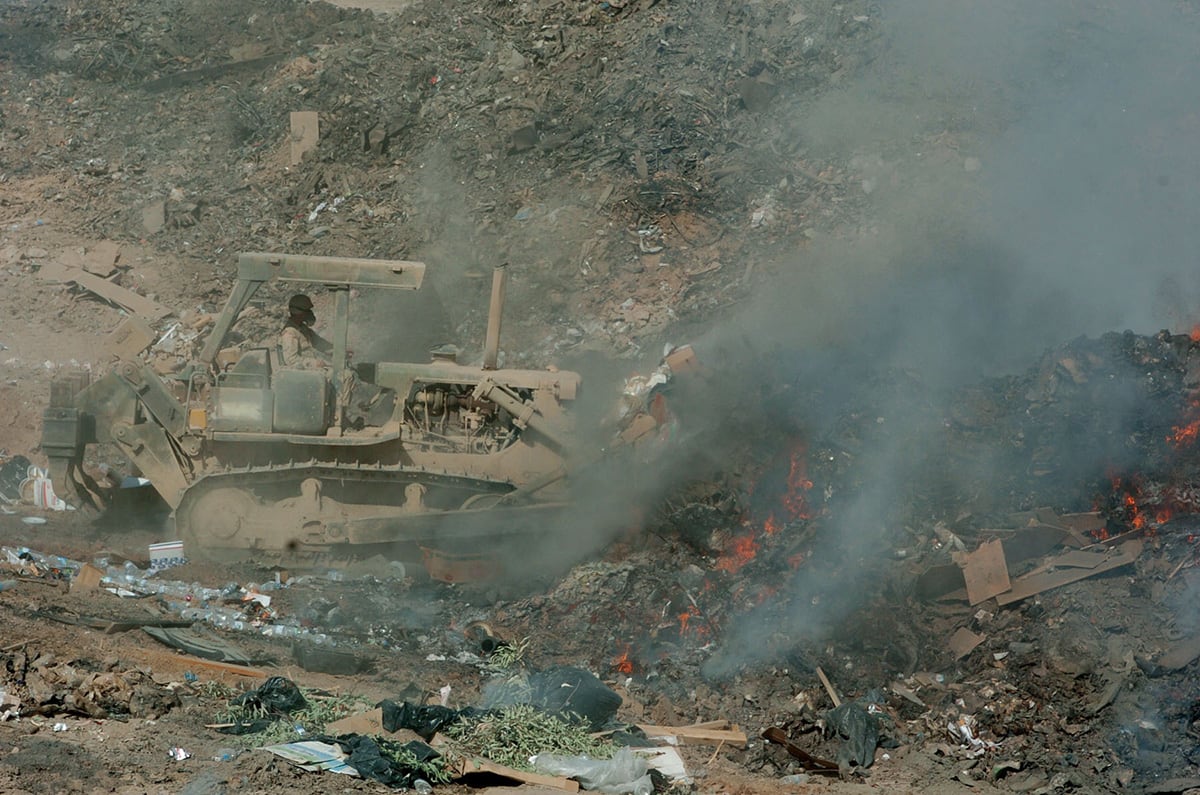Right now, there’s a soldier or Marine who deployed to Iraq as the new year rolled in and tensions escalated between the U.S. and Iran. That service member was trained to dismount and return fire during convoy ambushes, take cover during airstrikes, and detect improvised explosives during patrols. He can confidently engage the enemy at any phase within the continuum of combat, from indirect fire to a knife fight. No enemy is too formidable to defeat, at least in his mind. But he’s wrong.
There’s one enemy he faces that he is not trained to fight, much less defeat. An enemy that respects no battle positions, needs no grid coordinates to strike, and avoids no confrontation or foe. In fact, this particular enemy is a byproduct of America’s edge in manpower and technological superiority. A veritable product of the environment in which fighting occurs. One that has killed more Americans by the droves than any other enemy since the dawn of modern-day warfare. That enemy is toxic environmental exposure.
Toxic environmental exposure, within the context of this commentary, does not refer to every possible hazard or contaminant that a service member might encounter. Some are unavoidable occupational risks that are incidental to military service. High intensity noise, inoculations for certain geographically concentrated diseases such as malaria, natural airborne particles like sand and dust, and extreme heat and cold, just to name a few. As if those weren’t bad enough, however, some toxic exposures are of the self-inflicted variety. Evils with downstream consequences, necessitated by a perceived, more immediate greater good. In other words, a “win now, pay later” problem, where the “pay” part often comes with conditions, after the fact, that beg the questions of who ultimately wins in the end and whether it was worth the cost.
Case in point, once military generals figured out that removing foliage in the jungles of Vietnam would make it easier to spot enemy troop movements and positions from the air, a dioxin called Agent Orange was widely used to kill the foliage and, in turn, detect and hit a more visible enemy. But it would also kill an estimated 2.8 million U.S. veterans from diseases as a result of handling, breathing, and unwittingly consuming the dioxin. It would take the government decades to finally own up to the problem, when Congress passed and President George H. W. Bush signed the Agent Orange Act of 1991. This federal law required the Department of Veterans Affairs (VA) to award benefits to veterans who were diagnosed with certain diseases and served on active duty in the Republic of Vietnam during the recognized war time period.
The same fight would continue over five decades later until those who served on ships off the coasts of Vietnam were also authorized benefits with the passage of the Blue Water Navy Vietnam Veterans Act of 2019. Up until that point, VA maintained that Vietnam War veterans had been exposed to Agent Orange only if they served on land or in the country’s nearby or coastal waterways. It was the burden of those veterans to prove the virtually unprovable once VA had outright rejected the medical research, scientific evidence, and the well-documented high incidence of diseases among cohorts of veterans who’d served on ship that collectively substantiated the likelihood of exposure. It took a lawsuit and decision rendered by the U.S. Court of Appeals for the Federal Circuit in the case of Procopio v. Wilkie to settle the issue in favor of the claimants.
The Procopio decision would finally open benefits to veterans who served in the waters offshore of Vietnam during the war. It also would provide benefits to dependents or survivors of those veterans, at a cost of $52 million in 2020, and by $280 million over a 10-year period, according to estimates by the Congressional Budget Office. Additional costs related to medical care and administrative expenses for processing disability claims would raise the total to $70 million. Many believe it was sticker shock, not a sincere belief that exposure had not occurred, that undergirded the VA’s refusal to accept the evidence. It is for this reason the Procopio decision was a bittersweet win for veterans as it would open the door to another major concern. Who will pay for it? The answer: veterans themselves.
Despite the rising astronomical cost to care for and compensate veterans who’d fought a war that ended over a half century ago, how the cost was to be paid, through a process called PAYGO, would add even greater insult to injury. PAYGO, or the Statutory Pay-As-You-Go Act of 2010, created budget-reporting and enforcement procedures for laws affecting how the government spends taxpayer dollars. In simpler terms, it means one veteran benefit must be cut to pay for another; a “rob Peter to pay Paul” approach that often pitted classes of veterans against one another.
Because of PAYGO, a trade-off was necessary in order to extend Agent Orange benefits to Blue Water Navy veterans. That trade-off was a bipartisan deal to raise fees on initial home loans for families buying homes using their VA benefits. Compare that to an instance where 1st Recon Battalion/Charlie Company could only get the new Joint Light Tactical Vehicle if the 82nd Airborne/1st Brigade Combat Team gave up part of the budget they needed to replenish its ammunition reserves. Then imagine both units weren’t told about the PAYGO rule until they were under attack and taking causalities. One might then understand how many veterans feel.
More alarming is the fear the blue water Navy veteran experience likely foreshadows how future claims of toxic environmental exposure will be handled. Debates have already ensued over illnesses associated with Persian Gulf War service in Southwest Asia, as well as Operations Enduring Freedom, Iraqi Freedom, and New Dawn, where toxic exposure to burn pits were a common way to get rid of waste at military sites. At issue are unexplained illnesses, including conditions that affect skin, eyes, respiratory and cardiovascular systems, gastrointestinal tract and internal organs, among veterans who worked near areas where chemicals, paint, medical and human waste, metal cans, munitions, unexploded ordnance, petroleum products, plastics, and rubber were routinely burned.
Were younger and future veterans given a preview of what they’ll face when it’s their turn to fight for their lives as they age with unexplained illnesses? Will they also inevitably face a government that is slow to accept responsibility and deal with a PAYGO scheme that will make the receipt of benefits difficult even if the government concedes? Granted, service members knew what they were signing up for when they raised their right hand and took the oath. But no enlistment document contains fine print that makes mention of strained due process in the event the inductee is sickened by toxic environmental exposure and the PAYGO hurdle that will essentially force her to choose between her livelihood and that of her comrades, as was the case with Vietnam War veterans.
Remember the soldier or Marine who is standing the watching between America and Iran right now? He’s the reason our government needs to invest adequate resources into fully researching, diagnosing and treating conditions associated with toxic environmental exposures, and factor those costs, to include compensatory and survivor benefits, into the equation when calculating the actual cost of war. Our troops don’t sign promissory notes in disappearing ink when they volunteer to defend the United States of America, even when the costs become extraordinarily high. Our government should not be allowed to, either.
Sherman Gillums Jr. is a retired U.S. Marine Corps officer and chief advocacy officer at AMVETS, a congressionally chartered national veterans service organization representing the interests of more than 20 million veterans.
Editor’s note: This is an Op-Ed and as such, the opinions expressed are those of the author. If you would like to respond, or have an editorial of your own you would like to submit, please contact Military Times managing editor Howard Altman, haltman@militarytimes.com.




